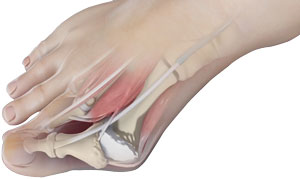Bunion Surgery

A bunion, also known as hallux valgus, is bony prominence at the base of the big toe, which often results in pain, redness and rubbing in footwear. A bunion can change the shape of your foot, make it difficult for you to find shoes that fit correctly and worsen the symptoms if left untreated.
Conservative treatment measures can help relieve the discomfort of a bunion, however, these measures will not prevent the bunion from becoming worse. Surgery is the only means of correcting a bunion and is usually recommended when conservative measures fail to treat the symptoms of a bunion.
What are the Surgical Options for a Bunion?
There are many surgical options to treat a bunion. The common goal is to realign the bones in the foot, correct the deformity, and relieve pain and discomfort. The surgery is performed as a day procedure, under the effect of a light general anaesthetic and a regional nerve block. When you wake up, you will not be in pain and will be able to walk on your foot right away.
Osteotomy is a common type of bunion surgery that involves the surgical cutting and realignment of the bones around your big toe. Your surgeon selects the appropriate surgical procedure based on the type of bunion and its severity.
There are 3 main types of osteotomies used by foot and ankle surgeons; namely Akin osteotomy, Chevron osteotomy, and Scarf osteotomy.
- Akin Osteotomy
Akin osteotomy corrects the sideways deviation of the big toe. In this procedure, your surgeon makes a small cut in the proximal phalanx (base of the big toe) and removes a wedge of bone to straighten the big toe. The bony fragments are then stabilized using screws or staples. This procedure is often used in conjunction with the other procedures below.
- Chevron osteotomy
Chevron osteotomy is usually recommended for mild to moderate bunion deformities. During this procedure, your surgeon will make an incision over your big toe. The joint capsule is opened and the bunion is removed using a surgical saw. A V-shaped cut is made on your big toe and the metatarsal bones are shifted to bring your toe into its normal anatomical position. The bunion is then shaved and the soft tissues are realigned to correct the position. Akin osteotomy may be performed if necessary. The mobility of your big toe is examined, and the capsule and wound are re-approximated with sutures. Screws or pins are used to hold the bones in their new position until healing takes place. This procedure can also be performed minimally invasively with keyhole style incisions.
- Scarf Osteotomy
Scarf osteotomy is usually recommended for moderate to severe bunion deformities. Your surgeon will make an incision along your big toe and open the joint capsule to expose the bump. The bump on your big toe is then removed using a bone saw. Your first metatarsal bone is then cut in a Z shape and realigned to correct the deformity. Your surgeon will fix the cut bone with pins or screws. The joint capsule and surgical wounds are then re-approximated using dissolvable sutures keeping your toe in a straight position. This is a very powerful corrective procedure with excellent long-term results.
Arthrodesis: This surgery involves fusing the two bones that form the big toe joint. This procedure is used for severe bunions and when arthritis is present. The movement of your big toe is reduced following this procedure, but pain and deformity are very well controlled.
What are the Risks and Complications of Bunion Surgery?
As with any surgery, bunion surgery involves certain risks and complications which include:
- Infection
- Recurrence of the bunion
- Nerve damage
- Unresolved pain and swelling
- Joint stiffness or restricted movement
- Delayed healing or healing in the wrong position
In rare cases, a second surgery may be necessary to correct the problems.
What is the Postoperative care for Bunion Surgery?
Following the surgery, patients should follow all instructions given by the surgeon. These include:
- Keep your dressings dry and leave them in place until your next out-patient appointment.
- Minimize walking where possible.
- Elevate the foot to minimize swelling as much as possible for the first 6 weeks.
- You will have to wear specially designed post-operative shoes to protect the wounds and assist in walking.
You may not be able to wear regular shoes for 6 weeks.
Related Topics
- Bunion Surgery
- Ankle Sprain Surgical Intervention
- Cheilectomy
- Surgery for a Torn Achilles Tendon
- Ankle Ligament Reconstruction
- Ankle Joint Replacement
- Arthroscopic Ankle Surgery
- Ankle Fusion Surgery
- Foot and Ankle Trauma
- Foot and Ankle Conditioning Program
- Foot & Ankle Rehabilitation
- Minimally Invasive Bunion Surgery
- Minimally Invasive Achilles Repair
- Minimally Invasive Ankle Ligament Repair
- Lesser Toe Surgery
- Minimally Invasive Foot Surgery
- Big Toe Arthroscopy




